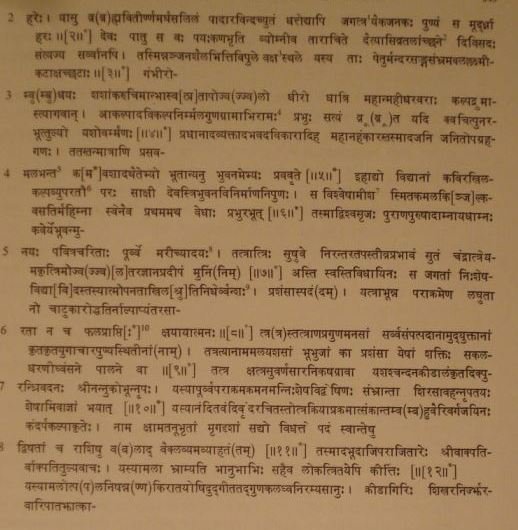|
INSCRIPTIONS OF THE CHANDELLAS OF JEJAKABHUKTI

______________________________
[1] And not tra as read by Kielhorn. The middle cursive stroke is clear though smaller. In all the insurances below, where the stroke is clear, I have taken the akshara as ttr.
[2] As already suggested by Kielhorn, read  , Probably the preceding word is intended to be (Sanskrit). , Probably the preceding word is intended to be (Sanskrit).
[3] The visarga is dropped in accordance with the vārttika on Pāṇini VIII, 3, 36.
[4] The akshara  , which was originally omitted, is written above the line. Kielhorn also observed that the first half of this verse does not admit of a proper construction but he has not proposed any emendation, which I propose as , which was originally omitted, is written above the line. Kielhorn also observed that the first half of this verse does not admit of a proper construction but he has not proposed any emendation, which I propose as  :, Kielhorn translates the first pause of the second quarter of this verse as ‘firm like the Creator’; but I think that what is intended here is dhātrī, the Earth, as often found in Sanskrit literature. For similarity of construction in the last foot of this verse, see C. I. I., Vol. IV. p. 413, v. 22. :, Kielhorn translates the first pause of the second quarter of this verse as ‘firm like the Creator’; but I think that what is intended here is dhātrī, the Earth, as often found in Sanskrit literature. For similarity of construction in the last foot of this verse, see C. I. I., Vol. IV. p. 413, v. 22.
[5] Originally  , with the sign of anusvāra later on scratched off. The idea in this verse is taken from the Sāṁkhya system of Philosophy. , with the sign of anusvāra later on scratched off. The idea in this verse is taken from the Sāṁkhya system of Philosophy.
[6] The two aksharas  were at first omitted and subsequently written above the line. were at first omitted and subsequently written above the line.
[7] See n. 3. above.
[8] The other sages created by Brāhman are named in the Mk. P., Canto. L. One of them was Atri who begot the Moon.
[9] Read  . The daṇḍa that follows is superfluous. . The daṇḍa that follows is superfluous.
[10] For dropping the visarga. see n. 3, above.
|